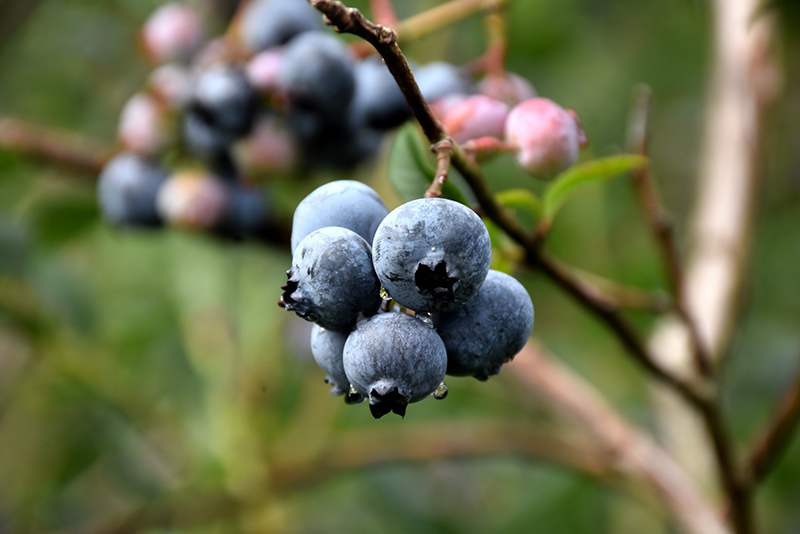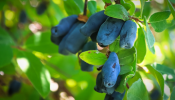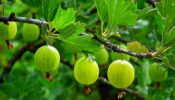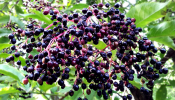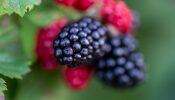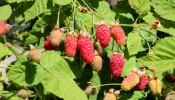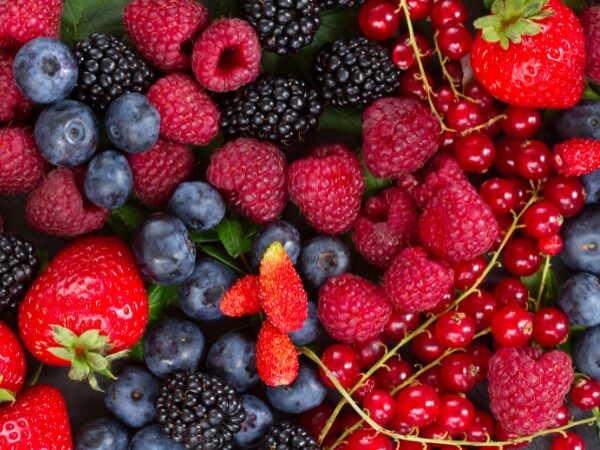
Growing Your Own Small Fruit
Enjoy the taste of summer by planting rhubarb, strawberries and raspberries in early Spring. Here are a few tips on adding them and more to your garden.
Rhubarb
Prepare a hole 2 feet deep and fill the bottom with a half and half mixture of composted manure and soil. Plant the crown 2 inches below soil level and firm evenly around the root. Soak well using an all-purpose 20-20-20 fertilizer. Rhubarb plants are heavy feeders and need regular feeding with a fertilizer such as a 4-12-8. Do not harvest the stalks the first year after planting so they can build strength for the following years. In the fifth year, the rhubarb can be divided.
Strawberries
At planting time, prepare the soil by adding plenty of composted manure to provide a rich soil that will hold moisture. Plant a double row 12 inches apart in both directions, each double row 2 to 4 feet apart. Set the plants so that the mid-point of the crown is at soil level. Spread the roots out near the surface before covering them with soil to allow proper air circulation and prevent root rot. Water in with an all-purpose 20-20-20 fertilizer. Pick off blossoms in the first season to produce strong plants for next year. Fall mulching with straw or similar material is important for proper winter protection.
Raspberries
Prepare the soil by mixing in peat moss and composted manure thoroughly. Plant the canes 1 to 2 inches deeper than they were growing so that the first roots are 2 inches below the soil level. Plant the canes 15 to 18 inches apart in rows 2 to 4 feet apart. Water well with an all-purpose 20-20-20- fertilizer and firm in the plants. Raspberries bear on last year’s wood. After bearing, the cane dies. To encourage new cane development, trim out dead canes and then thin out new canes to stand every 6 inches apart to ensure good fruit production. Regular fertilizing will increase yield.
Blueberries
Blueberries require acidic soil, so before planting, mix in a lot of peat moss. Blueberry bushes should be planted in early spring. Space plants about 5’ apart. Mulch plants to keep the roots evenly moist and apply fertilizer one month after planting (not at the time of planting). If your soil is not naturally acidic (with a PH of 4 or 5) amend the soil with a soil acidifier every month or so. Blueberries are not self-pollinating and need more than one variety to produce fruit. For the first couple of years pinch back the blossoms to stimulate growth and create a stronger plant. Blueberries will be ready to harvest in July-mid August. For the first few years after planting, there is no need to prune blueberry bushes. After that, pruning is needed to stimulate the new growth that will bear fruit the following season. Prune plants in late winter or very early spring, before growth has begun.
Blackberry
Harvest time depends on the variety. Large, dark purple berries with a sweet taste. The plant should be planted as soon as possible (March–May). Before planting remove from pot and soak roots in a bucket of water for 3 – 4 hours. Choose a sunny location with well-drained soil. Plant about 16” apart. Continue to water well for the first few weeks. Feed by mixing in manure or fertilizer. Most varieties of blackberries are self-pollinating, meaning they do not need another variety to produce fruit. In the fall, prune out canes that produced fruit.
Haskaps (Honeyberries)
Haskaps, also known as Honeyberries, are deciduous fruit-bearing shrubs that grow about 4-6’ tall. The flavour of the berry is a mix between a blueberry, Saskatoon berry and raspberry. Haskaps are native to cooler temperatures so are ideal for our Canadian climate (hardy to zone 2) and can be planted in spring or fall. Plant in full sun and well-drained soil, although they can grow in moist soil. For individual bushes, plant about 5’ apart. Berries ripen in June and the flavour improves if left longer on the bush. For best fruit production you will need at least two varieties for pollination. Bushes can often produce fruit the very first year after planting, but yield increases significantly after two or three years. To keep shape prune in late winter or very early spring and thin out older branches when the shrub gets too dense.
Gooseberry
A vigorous plant producing plump, large, flavourful fruit ready for harvest mid-summer. Berries hang away from the plant, making them easy to pick. Canes have thorns. Grows about 3’ high and wide. Plant in full sun to light shade and well-drained soil. Gooseberries are self-pollinating and do not need another variety to produce fruit. Plant root ball so that its top is at or slightly above the surrounding soil level – do not plant too deeply. Water thoroughly (once a week) for the first year. Mulch deeply. Fertilize lightly with garden food early each spring. Prune in late fall or winter.
Currants
Currants are deciduous fruiting shrubs with berries that are either red, black or white. The plant grows about 3-6’ and the fruit ripens in summer (ripening time depends on variety). Fruits are tart and excellent eaten fresh or used in jams and jellies. Currants are self-pollinating and do not need another variety to produce fruit. When planting, mix soil with ½ triple mix. Plant root ball so that its top is at or slightly above the surrounding soil level – do not plant too deeply. Water thoroughly (once a week) for the first year. Mulch deeply. Fertilize lightly with garden food early each spring. Prune in late fall or winter.
Grapes
Grapevines not only produce sweet and versatile fruits, but they also add an element of drama to a garden or landscape. They are vigorous growers, and with the proper pruning, they will produce fruit with ease and can last longer than 30 years. Grapes should be planted in early spring. Make sure a trellis or arbour is in place before planting so the vine will have support. Most grapes are self-pollinating and only need one variety to produce fruit. Check with a garden centre attendant to be sure only one variety is needed. Before planting, soak roots in water for two to three hours. Plant in full sun and well-drained soil (keep the soil loose for air circulation). Plant grapes 6 to 10’ apart. Dig the hole slightly deeper than planted in the pot (don’t tamp down when refilling the hole) and water well. Prune the top back to two or three buds when planting. In the first couple of years, the vine should not be allowed to produce fruit. It needs to strengthen its root system before it can support the extra weight of fruit. Canes will only produce fruit once so prune annually when vines are dormant, in March or April. Remember, the more you prune, the more grapes you will have. Do not fertilize in the first year unless you have a problem with the soil. Fertilize lightly in the second year of growth and every year after. Use mulch to keep an even amount of moisture around the vines. Harvest time depends on the variety.
Elderberry
Elderberries are deciduous fruiting shrubs that produce bluish-black small berries that are used in jams, jellies, wines and juices. The berries are generally not eaten fresh as they are quite bitter. Berries are harvested towards the end of summer (mid-April – September). Plant elderberries in spring in full sun and well-drained soil. Amend soil with manure and peat moss. Elderberries will need consistent moisture, especially in the hot summer months. Plant bushes about 3’ apart. Pick off blossoms the first year to create a stronger plant and better yield the second year. Elderberries are partially self-pollinating. This means you will get some fruit with just one variety, but planting a second variety will increase fruit production significantly.
Please note the above list of plants are available at Canadale, but we can not guarantee that every plant is currently in stock. To ensure you find the plant you are looking for we strongly recommend visiting us at the garden centre or call us at 519-631-7264.
The fruits below are not currently available at the garden centre. If they are a part of your garden at home, here are some tips for helping them thrive.
Boysenberry*
Boysenberries are a cross between blackberries, raspberries and loganberries. They have a late summer harvest of long, dark purple fruit with a sweet taste. Growth is vigorous and the plants need to be tied to a fence. This plant should be planted as soon as possible (March–May). Before planting remove from pot and soak roots in a bucket of water for 3 – 4 hours. Choose a sunny location with well-drained soil. Plant about 6’ apart. Continue to water well for the first few weeks. Feed by mixing in manure or fertilizer. Boysenberries are self-pollinating and do not need another variety to produce fruit. In the fall, prune out canes that produced fruit.
Loganberry*
A blackberry-raspberry cross. Late summer harvest with large, long, dark red fruit with a sweet taste. Growth is vigorous and the plants need to be tied to a fence. The plant should be planted as soon as possible (March–May). Before planting remove from pot and soak roots in a bucket of water for 3 – 4 hours. Choose a sunny location with well-drained soil. Plant about 1’ apart. Continue to water well for the first few weeks. Feed by mixing in manure or fertilizer. Loganberries are self-pollinating and do not need another variety to produce fruit. In the fall, prune out canes that produced fruit.
Tayberry*
A blackberry-raspberry cross. Late summer harvest with large, long, dark red fruit with a sweet taste. Growth is vigorous and the plants need to be tied to a fence. The plant should be planted as soon as possible (March–May). Before planting remove from pot and soak roots in a bucket of water for 3 – 4 hours. Choose a sunny location with well-drained soil. Plant about 1’ apart. Continue to water well for the first few weeks. Feed by mixing in manure or fertilizer. Tayberries are self-pollinating and do not need another variety to produce fruit. In the fall, prune out canes that produced fruit.
Goji Berries*
Goji is a sprawling shrub with long, flexible canes and clusters of small, grey-green leaves. The flowers are a brilliant royal purple and they appear in late spring/early summer along the length of the canes. They give way to juicy, bright red fruits that resemble small peppers. They grow sweeter as they mature on the plant. Goji plants continue to flower and produce fruit through the first heavy frost. Full sun is best but tolerates a bit of shade. They grow to about 5-7’ tall. The plants tolerate some drought once established, but for the best fruit set and quality, water regularly. Goji naturally wants to sprawl and creep along the ground. To save space and to make harvesting the berries easier, you can bundle the strongest 3-5 canes around a 6-8’ tall stake. Goji does not require pruning to grow well and produce fruit. However, you may find the plant is more manageable and easier to harvest when its lateral (horizontal) branches are lightly pruned to encourage branching and the production of vigorous new growth. Goji berries begin to ripen in early summer. They should be plucked off by hand when they are brilliant red and taste sweet. For an abundant crop, apply a fertilizer formulated for flowering woody plants in early spring, just as new growth begins.
(*) = Not available at Canadale.
Updated April 10, 2024



